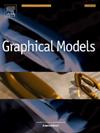L2-GNN:使用两次线性参数化的快速光谱滤波的图神经网络
IF 2.2
4区 计算机科学
Q2 COMPUTER SCIENCE, SOFTWARE ENGINEERING
引用次数: 0
摘要
为了提高不规则三维形状的学习能力,例如具有不同离散化的网格和不同采样的点云,我们提出了L2-GNN,一种新的图神经网络,它使用两次线性参数化来近似光谱滤波器。首先,利用小波滤波基函数对谱滤波器进行参数化。参数化允许扩大图卷积的接受域,可以同时捕获低频和高频信息。其次,利用切比雪夫多项式基函数对小波滤波器基函数进行参数化。这种参数化降低了图卷积的计算复杂度,同时保持了对网格离散化和点云采样变化的鲁棒性。基于快速光谱滤波的L2-GNN可用于不规则网格或点云数据的形状对应、分类和分割任务。实验结果表明,我们的方法在质量和效率方面都优于目前的技术水平。本文章由计算机程序翻译,如有差异,请以英文原文为准。

L2-GNN: Graph neural networks with fast spectral filters using twice linear parameterization
To improve learning on irregular 3D shapes, such as meshes with varying discretizations and point clouds with different samplings, we propose L-GNN, a new graph neural network that approximates the spectral filters using twice linear parameterization. First, we parameterize the spectral filters using wavelet filter basis functions. The parameterization allows for an enlarged receptive field of graph convolutions, which can simultaneously capture low-frequency and high-frequency information. Second, we parameterize the wavelet filter basis functions using Chebyshev polynomial basis functions. This parameterization reduces the computational complexity of graph convolutions while maintaining robustness to the change of mesh discretization and point cloud sampling. Our L-GNN based on the fast spectral filter can be used for shape correspondence, classification, and segmentation tasks on non-regular mesh or point cloud data. Experimental results show that our method outperforms the current state of the art in terms of both quality and efficiency.
求助全文
通过发布文献求助,成功后即可免费获取论文全文。
去求助
来源期刊

Graphical Models
工程技术-计算机:软件工程
CiteScore
3.60
自引率
5.90%
发文量
15
审稿时长
47 days
期刊介绍:
Graphical Models is recognized internationally as a highly rated, top tier journal and is focused on the creation, geometric processing, animation, and visualization of graphical models and on their applications in engineering, science, culture, and entertainment. GMOD provides its readers with thoroughly reviewed and carefully selected papers that disseminate exciting innovations, that teach rigorous theoretical foundations, that propose robust and efficient solutions, or that describe ambitious systems or applications in a variety of topics.
We invite papers in five categories: research (contributions of novel theoretical or practical approaches or solutions), survey (opinionated views of the state-of-the-art and challenges in a specific topic), system (the architecture and implementation details of an innovative architecture for a complete system that supports model/animation design, acquisition, analysis, visualization?), application (description of a novel application of know techniques and evaluation of its impact), or lecture (an elegant and inspiring perspective on previously published results that clarifies them and teaches them in a new way).
GMOD offers its authors an accelerated review, feedback from experts in the field, immediate online publication of accepted papers, no restriction on color and length (when justified by the content) in the online version, and a broad promotion of published papers. A prestigious group of editors selected from among the premier international researchers in their fields oversees the review process.
 求助内容:
求助内容: 应助结果提醒方式:
应助结果提醒方式:


